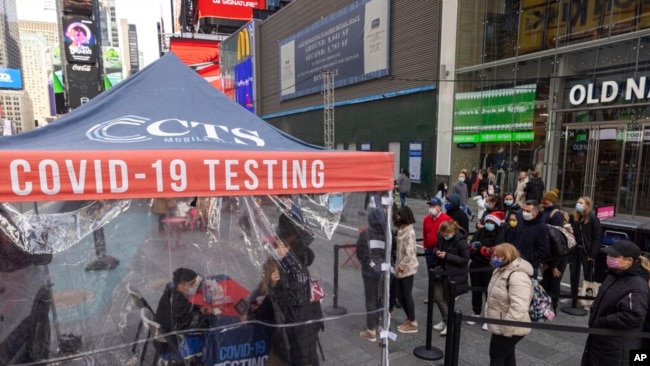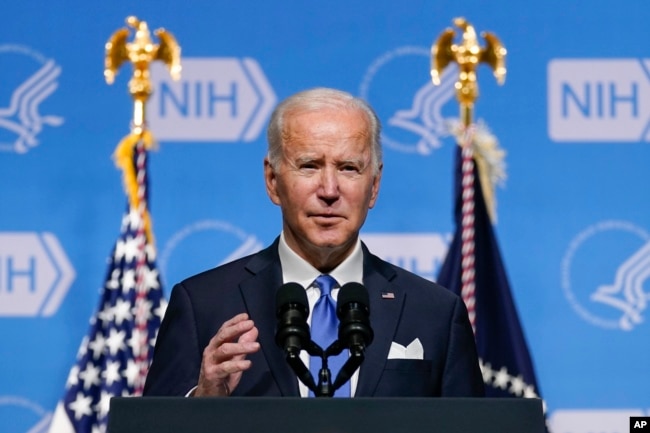感染者が多いアメリカで、隔離期間が短縮されたとのVOAニュースです。
QuarantineとIsolationd、CDCサイトで確認しましょう!!
米国保健当局、COVID-19の人に対する予防的分離のガイドラインを緩和(和訳)
US Health Officials Ease Preventive Separation Guidelines for People with COVID-19
December 28, 2021
米国保健当局は、コロナウイルスに感染した米国人のうち、感染の兆候を示さない人に対する検疫の制限を引き下げました。
感染の兆候のない人は、10日間ではなく、5日間隔離する必要があると当局は言っています。保健当局はまた、ウイルスにさらされた人が他の人に近づかないようにする期間も短縮しました。
疾病管理予防センターの職員は、月曜日にこの変更を発表しました。同機関によれば、コロナウイルス感染者は、症状が出る前の2日間と出てから3日間に最も感染力が強いという証拠が増えているとのことです。
この決定は、オミクロン版(変種)ウイルスのためにCOVID-19の症例が大幅に増加したことも要因となっています。
初期の研究では、オミクロンは新型コロナウイルスの初期バージョンよりも重症化しない可能性が示唆されています。しかし、多くの人が感染して隔離されることで、ビジネスに支障をきたしていると専門家は言います。
先週、当局は医療従事者に対する規則も変更しました。これまでは、医療従事者は検査でウイルスに感染していることが判明した場合、10日間は仕事から離れるべきとされていました。新しいガイドラインでは、検査でウイルスに感染しておらず、症状もない場合は、7日後に仕事に戻ることができるとしています。
月曜日、CDCは一般市民に対する隔離と検疫のガイダンスを変更しました。この変更は、症状が出ていない人を対象としています。隔離中に症状が出た人は、家にいるべきだと同機関は述べています。
リンジー・ワイリー氏はアメリカン大学の公衆衛生法の専門家です。彼女は、CDCの検疫ガイダンスは一般市民を混乱させるものであると述べています。そして、新しい勧告は、"多くの人々が初めて陽性と判定され、ガイダンスを探している時に起こっている "と述べています。
Isolation 隔離について(感染症に感染した人の隔離)
隔離のルールは、感染者のためのものです。ワクチン未接種、一部接種、完全接種、ブースター注射を受けた人も同じです。
ルールでは、陽性と判定された日から隔離を開始することになっています。感染者は10日間ではなく、5日間隔離を受ける必要があります。
5日後、症状がなければ、通常の活動に戻ることができます。しかし、少なくともあと5日間は、どこでもマスクを着用しなければなりません。5日後にも症状がある場合は、症状が改善されるまで通常の活動に戻る必要があります。
Quarantine 隔離について(感染症に感染した可能性がある人の隔離)
隔離のルールは、感染者と密接に接触していたが、自分自身は感染していない人が対象です。
隔離は、ウイルスに感染した可能性があると言われた日から始まります。
以前は、CDC は完全にワクチンを接種していない、感染者と密接に接触した人々 は、少なくとも 10 日間家に滞在する必要があると述べています。現在では、追加接種を受けた人だけは、隔離の必要がないとしています。
5日間
感染した場合、5日後には感染の危険性は下がりますが、すべての人になくなるわけではありません、とアーロン・グラット医師は言います。彼はアメリカ感染症学会のスポークスマンです。
「5日間に短縮しても、まだ少数ではありますが、かなりの数の人が感染していることになります」と、博士は述べています。
tこのため、マスクの着用はCDCの指針の重要な部分である、と当局者は述べています。
義務ではない
CDCの新しいガイダンスは、義務ではありません。雇用主や州・自治体への勧告です。先週、ニューヨーク州は、医療従事者のためにCDCのガイダンスを拡大すると発表しました。
この変更は、「ビジネス界の利害関係者の圧力に応えたものと受け止められるだろう」とワイリー氏は言います。しかし、専門家の中には何カ月も前からこの変更を求めていた人もいたといいます。
US Health Officials Ease Preventive Separation Guidelines for People with COVID-19
United States health officials have reduced quarantine restrictions for Americans with the coronavirus who do not show signs of infection.
Individuals without signs of infection should isolate for five days, instead of 10, officials say. The health officials also shortened the time that those exposed to the virus should stay away from other people.
Officials from the Centers for Disease Control and Prevention announced the change on Monday. The agency said there is growing evidence that people with the coronavirus are most infectious in the two days before and three days after symptoms develop.
The decision was also driven by the large increase in COVID-19 cases because of the Omicron version, or variant, of the virus.
Early research suggests Omicron may cause less severe sickness than earlier versions of the new coronavirus. But the large number of people becoming infected and isolating themselves is hurting businesses, experts say.
Last week, the agency also changed rules for health care workers. Earlier, rules said that health care workers should stay away from work for 10 days if a test shows they are infected with the virus. The new guidelines say workers could go back to work after seven days if a test shows they do not have the virus and do not have symptoms.
On Monday, the CDC changed its isolation and quarantine guidance for the public. The change is aimed at people who are not experiencing symptoms. People who have symptoms during quarantine should stay home, the agency said.
Lindsay Wiley is a public health law expert at American University. She said the CDC’s quarantine guidance is confusing to the public. And the new recommendations are “happening at a time when more people are testing positive for the first time and looking for guidance.”
Isolation
The isolation rules are for people who are infected. They are the same for people who are unvaccinated, partly vaccinated, fully vaccinated or have the booster shot.
The rules say the quarantine starts the day of testing positive. An infected person should go into quarantine for five days, instead of 10.
At the end of five days, infected people may return to normal activities if there are no symptoms. But they must wear a mask everywhere for at least five more days. If there are still symptoms after five days, they should wait until symptoms improve before returning to normal activities.
Quarantine
The quarantine rules are for people who were in close contact with an infected person but not infected themselves.
A quarantine starts the day someone is told they may have been exposed to the virus.
Before, the CDC said people who were not fully vaccinated and who came in close contact with an infected person should stay home for at least 10 days. Now the agency says only people who get booster shots do not need to quarantine.
Five days
When people get infected, the risk of spread drops after five days, but it does not disappear for everyone, said Dr. Aaron Glatt. He is a spokesman for the Infectious Diseases Society of America.
“If you decrease it to five days, you're still going to have a small but significant number of people who are contagious,” he said.
That is why wearing masks remains an important part of the CDC guidance, officials said.
Not a mandate
The new CDC guidance is not a requirement. It is a recommendation to employers and state and local officials. Last week, New York state said it would expand on the CDC’s guidance for health care workers.
The change “is going to be perceived as coming in response to pressure from business interests,” Wiley said. But she said some experts have been calling for the changes for months.
Words in This Story
quarantine – n. the period of time during which a person or animal that has a disease or that might have a disease is kept away from others to prevent the disease from spreading
isolation - n. the state of being in a place or situation that is separate from others
symptom –n. a change in the body or mind that shows that a disease is present
confuse – v. to make (someone) uncertain or unable to understand something
test positive –v. to have a test show that a disease is present in a person’s body
booster — n. an action or substance that makes something stronger or more effective
expose –v. to be affected by something; to experience something
significant — adj. large or important enough to be noticed or to have an effect
contagious - adj. able to be passed from one person or animal to another by touching
perceive — v. to notice or to become aware of something
新型コロナウイルス感染症の隔離:QuarantineとIsolationの違い
CDC(アメリカ疾病予防管理センター)ウェブサイト
Quarantineは、新型コロナウイルス感染症に感染した可能性がある人を、他の人から遠ざける(away from)ために用いられます。Quarantineは、病気に気づく前の感染者、あるいは、無症状の感染者による感染拡大の防止に役立ちます。Quarantineされている人は自宅に待機し、他の人から離され、健康状態をモニターし、州や地方の保健局の指示に従う必要があります。
Isolationは、ウイルスの感染者(新型コロナウイルス感染症で症状のある人と無症状の人)と感染していない人を離す(separate)ために用いられます。Isolationされている人は、他の人の周りにいることが安全になるまで自宅に待機する必要があります。自宅では、病気の人や感染者は、(可能であれば)「病人用の部屋」やエリアに滞在し、別のバスルーム(洗面所・トイレ)を利用することで、他の人から離される必要があります。

